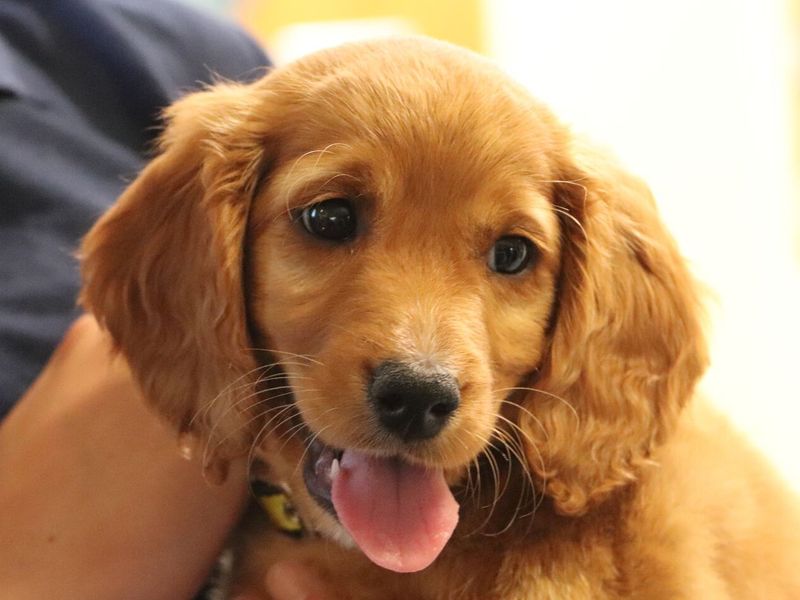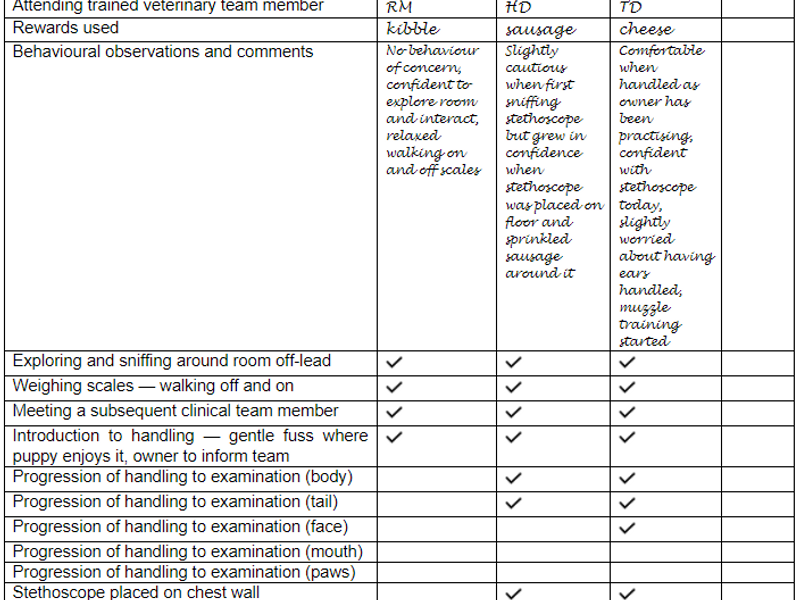Habituation and socialisation appointments for puppies
Habituation and socialisation appointments promote good welfare and teach puppies to feel relaxed and confident.

Habituation and socialisation appointments are a fantastic opportunity to promote good welfare. They teach puppies to feel relaxed and confident in the veterinary clinic, preparing them for times when they might need to undergo treatment.
Clinics might also benefit from increased client-clinic bond and greater opportunities to discuss husbandry and general health with owners.
This is the start of the owner’s adventure with their puppy. They will be getting to know one another and developing a bond, so cementing the vet team as a source of expertise will provide invaluable support and reassurance, particularly for first-time owners.
What do we mean by habituation and socialisation?
It is well established that the experience of puppies in their first weeks of life will have lasting effects on their behaviour and health.
Habituation
This is all about the places and the things in the places.
Puppies need to be exposed to a broad range of common sights, sounds, smells and substrates in a gradual and positive way.
This is so that they remain insignificant and do not cause a dog to become worried or frightened when settling in the waiting room.
Socialisation
This is all about living beings.
To help prevent behavioural problems from developing, young puppies will benefit from carefully managed exposure to a range of different people and other dogs and animals.
Having different types of interaction with people and other animals, as part of a positive and gradual process, will help puppies accept this comfortably as a normal part of life.
First visit to a veterinary clinic
In the UK, puppies are usually microchipped by 8 weeks of age, and for many, this will be their first encounter with the veterinary clinic.
If they find this to be an unpleasant experience, they might expect to experience the same unpleasant outcome the next time they’re in the clinic environment.
Learning that it can be an enjoyable and rewarding place to visit will be of significant benefit, preparing them for whenever they need to return to the clinic.
What should habituation and socialisation clinics involve?
Habituation and socialisation clinics are usually started after the puppy’s primary vaccination course. They involve the puppy being gradually introduced to the veterinary environment and available equipment, as well as different members of the clinical team.
Habituation in relation to the veterinary clinic involves getting used to:
- getting on and off the weighing scales and table – if required, or when they cannot be examined on the floor
- the sights, sounds and smells of the clinic including different types of odours, flooring, and lighting
- the sights, sounds, and smells of different types of equipment such as stethoscopes, blood pressure monitors, ophthalmoscopes, otoscopes, and thermometers
- travelling to and from the clinic.
Socialisation involves enjoyable exposure to:
- the clinical team, including receptionists, nurses, vets, and auxiliary staff, in a variety of uniforms, and interacting with them in a positive, appropriate way
- being gently restrained and examined
- various forms of treatment application/medication administration, such as topical parasitic control, ear and eye drops and tableting.
Less is more – take care not to overwhelm a puppy
The aim of each appointment is to ensure a positive association is made with the clinic, and the people and things within it – but that doesn’t mean doing everything all in one go!
Having a very gradual introduction means a puppy can take their time to get used to things, without becoming overwhelmed or ‘flooded’ with too much sensory experience happening all at once.
If this happens, a puppy can become so overloaded with information that they are unable to process and form good associations with what they’re encountering.
Going at each puppy’s pace means they can always have a positive experience, in which they’re primed to learn good associations with what’s happening to and around them.
For some puppies, this might mean simply allowing them to sniff and explore the consult room during their first appointment.
However, other puppies might feel more confident and be able to meet someone new, experience some gentle interaction with a stethoscope, and be encouraged to climb onto the weighing scales.
The key is in interpreting how a puppy is feeling about what is happening by monitoring their body language and making sure things stop if they show any signs of distress so they can retreat to where they feel safe – which is likely to be with their owner.
At this young age, puppies are still learning to see their owners as a point of trust and social support and will be developing unique relationships.
To promote positive dog-owner relationships, vet teams can help owners understand how their puppies are communicating their feelings and how to respond appropriately, such as providing reassurance when necessary and taking steps to help their puppies feel safe.
Ensuring a safe experience
As with any clinical appointment, the environment must be disinfected between patients. This will leave a residual scent which is part of the habituation process. If a puppy learns to associate that scent with ‘good things happening here’, then it will trigger feelings of happiness rather than worry.
As puppies will be permitted off-lead, it is vital to ensure that exits are safely closed and signs are in place to safely manage the arrival of anyone to the area, explaining how they should behave should they need to enter.
It can be incredibly tempting to rush up to puppies to give them a fuss, but this risks them becoming suddenly overwhelmed by the experience and associating the vet clinic with suddenly being interacted with by someone unfamiliar, which could be alarming for them.
Vet teams, especially receptionists, can be instrumental in helping to manage this within waiting rooms, where irresistible puppies might be at risk of other owners and staff wanting to come and interact with them.
Politely explaining why ‘resisting the irresistible’ is important to the well-being of the puppy both gives people useful knowledge about how to interact with dogs and can also help the puppy to develop good feelings about unfamiliar people and places.
Ensuring a positive emotional experience
Owners can be asked to provide some of their puppy’s favourite treats to help build a positive association with the veterinary environment.
Any signs of relaxation or positive interaction may be reinforced by feeding the puppy a treat immediately. However, should a puppy appear reluctant to take a treat, it may be dropped onto the floor, or into a bowl, for the puppy to eat by themselves.
This removes any additional pressure of having to approach someone they aren’t yet familiar with, or their owner, in this environment where they might still be feeling unsure about what is going to happen.
Encouraging good behaviour
Regardless of how the puppy behaves, the member of the clinical staff facilitating the appointment must advise the owner not to use any coercion or physical means to manipulate their puppy throughout the area.
They can explain that scolding a puppy for behaving in an undesirable way, such as toileting or chewing, risks damaging the owner-dog and dog-clinic relationship by creating unpleasant associations with the person punishing them, and the environment they are being punished in.
This is a valuable opportunity to discuss how to ensure that desired behaviour is reinforced through immediate delivery of something the puppy finds rewarding.
If the puppy is behaving in an undesirable and/or unsafe way, rather than tell them off it is better to interrupt them quickly, calmly, and quietly, in order to redirect their attention into a desired behaviour that can then be rewarded.
Examples of neutral ways to interrupt unwanted behaviour include:
- moving away from the puppy and calling them
- making a distinct sound such, as a kissing noise, to gain their attention
- engaging with a toy in an animated way so the puppy is encouraged to quit what they’re doing in favour of interacting with the toy instead.
Owners will benefit from understanding that through careful consideration of the situation in which they are putting their puppy, and some positive planning, they can guide them into behaving in desirable ways and reward them for doing so.
Introduce clinical stimuli gradually and incrementally
The aim of the habituation/socialisation clinic is to allow the puppy to acclimatise to the veterinary environment by allowing them to investigate and explore it without feeling restricted or becoming worried.
Any person or piece of equipment within the environment should initially be systematically introduced at a low level at which the puppy is observed to be showing an indifferent or positive response.
For example, this might be the presence of a clinician remaining at a distance from the puppy to begin with, or the sound of clippers being turned on but initially placed safely out of reach and out of the puppy’s sight.
Record-keeping and signposting as necessary
As with routine appointments, notes can be made on the dog’s medical record regarding any concerns over the dog’s behaviour within the clinic or any concerns raised by the owner.
Where a more demanding behavioural problem exists, it is important that clinical staff refer owners to an accredited dog trainer or behaviourist. Here, problems can receive guidance from relevant professionals with the experience and understanding required to address problematic behaviour appropriately .
Ideally, the same trained member of the veterinary team would conduct the initial appointments, but this might be not possible for every clinic, hence the need to maintain records. It can be helpful to create a progress chart to record each puppy’s breadth of experience.
This can also act as a prompt to remind the clinician that a puppy does not have to experience exposure to every item at every visit and to always work at the dog’s pace, therefore monitoring them for signs of relaxation at every stage.
An example of a semi-completed checklist for use within habituation/socialisation appointments is shown below.

How many appointments will be necessary?
There is no limit to these types of appointments because every time the dog arrives at the clinic and experiences a positive outcome they are creating a bank of ‘good experiences’.
These can help them be resilient to visits which might be perceived as unpleasant or frustrating (different to what the dog has grown to expect).
It is unlikely that this depth of resilience can be achieved following one single positive exposure to the clinical environment.
However, to reduce the impact upon medical appointments, owners living locally can be encouraged to regularly visit the clinic, at quieter times if appropriate, to practice settling their dogs within the waiting area, weighing them, and allowing them to enjoy spending some brief but rewarding time within the environment.
Join the Dog Friendly Clinic scheme
Join the Dog Friendly Clinic Scheme today and become part of the behaviour-centred veterinary community.
Request an application pack for an individual membership
Is your Clinic ready to become a registered Dog Friendly Clinic?
Register your interest today and we'll send you an application pack with information about the criteria your clinic needs to meet to become part of the scheme.
Disclaimer notice: The advice given on this website [in these materials] is intended for your general information only and should not be relied upon as specific advice for any veterinary practice or clinic. Each veterinary practice or clinic will be unique in its physical environment and each dog attending the veterinary practice or clinic will have specific needs and requirements, which the veterinary practice or clinic is solely responsible for. Unless prohibited by law, Dogs Trust and the British Veterinary Behaviour Association do not accept liability to any person veterinary practice or clinic relating to the use of this information.
Related articles

Puppy events within veterinary clinics

